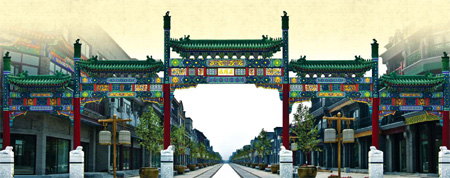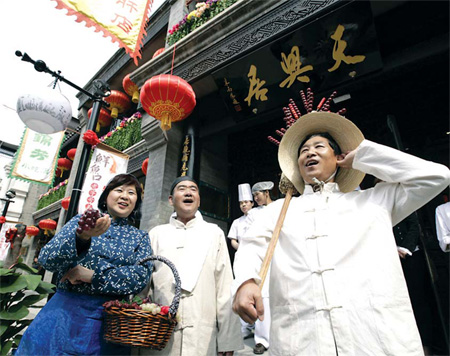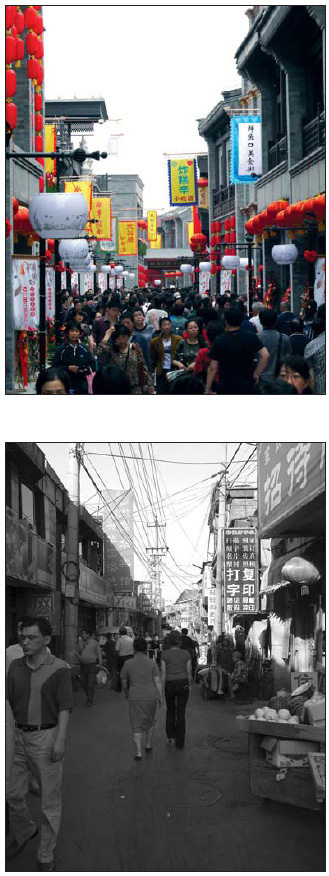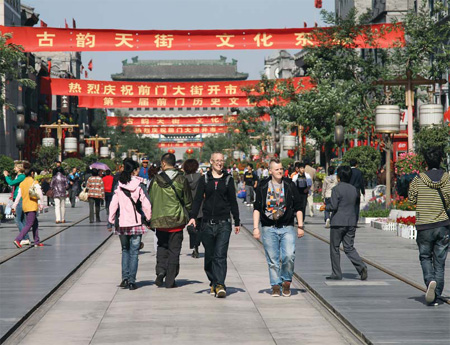Editor's Pick
Qianmen renovation: Gateway to prosperity
Updated: 2011-05-12 08:01
By Xu Xiao (China Daily)
|
Restored Qianmen Street along the former royal pathway during the Ming and Qing dynasties. Photos Provided to China Daily |
|
Peddling goods by chanting is a unique skill used by street vendors. |
Historic neighborhood in Beijing finds new life after a 13 billion yuan facelift
Visitors to Beijing are likely to tour the Forbidden City, Tiananmen Square, the Summer Palace and city gates formerly connected by tall, fortified walls.
But for those who want to discover the past and current lifestyle of locals, the Qianmen area is the place to go.
Qianmen Street and its neighborhood have been witness to Beijing's historic transformations over two dynasties and serve as a showcase of the city's folk customs, commerce and culture.
At the south end of the old city and neighboring famed Tiananmen Square, the Forbidden City and Temple of Heaven, Qianmen Street was born along with Beijing when it became the Ming Dynasty (1368-1644) capital more than 600 years ago.
Six centuries
Over those six centuries, the city underwent tremendous changes - the fall of dynasties and demolition of the city's walls - but life in Qianmen continued, even in the hardest times, creating historical and cultural legacies that survive today.
But in the past few decades local residents and authorities have faced new problems - endangered ancient buildings and relics, outdated facilities that fail to meet modern needs, deteriorating living conditions and a commercial sector selling faked and poor-quality goods.
Start in 2005
As Beijing continued to prosper and modernize, the district government began renovation of the Qianmen area in 2005.
Four years and more than 13 billion yuan later, builders had struck a balance between modernization and protection while improving the quality of life for residents.
The renovation work called for principals named the "four 100 percent": To inherit and promote traditional Chinese culture with 100 percent devotion, to save 100 percent of the relics and valuable buildings, to protect the intact outlook of the Qianmen area with 100 percent effort and to save 100 percent of the intangible cultural heritage.
Eventually, a shining new version of Qianmen Street appeared.
About 76 percent of the buildings along the street were repaired while maintaining their original look. The rest were rebuilt.
Workers also repaired and restored the symbols of Qianmen - the decorated archway of Zhengyang Gate, the 816-meter-long royal pathway of the Ming and Qing (1644-1911) dynasties and the trolley bus that disappeared for 42 years.
The area's opera house and guild hall - both city-level relics - were restored. Several temples, public bathrooms and other traditional structures were saved.
As well, the hutongs and siheyuans - alleyways and courtyards - home to longtime Beijing residents were repaired and protected to preserve the traditional look of the city while improving living standards of residents.
The intensive work not only retained most of the historic look, but also greatly modernized the urban infrastructure.
Underground pipes to carry electricity cables, water, gas and heat were installed under the royal pathway, breaking through the bottleneck that constrained improvements in the area for decades.
Underground utilities
In all, 17,000 meters of pipeline was installed to carry public utilities that meet the needs of both residents and businesses.
Seven major streets were also renovated, with the revamped Qianmen Street officially opened to the public in May 2008 as a city landmark to attract visitors during the Beijing Olympic Games.
Renovation of the entire area was completed in 2009. This year, a gourmet street and a Taiwan commercial zone were added as attractions for both shoppers and tourists.
As one of the most traditional areas of Beijing, Qianmen Street has gathered together many time-honored business operations that exemplify Chinese business wisdom.
Thirteen traditional brands including Quanjude and Bianyifang - both renowned for roast duck - have resumed business along the street. Twenty-two others such as shoemaker Neiliansheng and tea dealer Wuyutai have also opened at Qianmen.
The traditional businesses are now mainly located on the northern block between the dining street Xianyukou and Zhengyang Gate watchtower.
To preserve the traditional style, planners mandated that most businesses along Qianmen Street should be old-style Chinese businesses. They now account for more than 70 percent of operations along the street, with foreign brands comprising less than 30 percent.
To add further support, a foundation for the area's time-honored brands was started in 2008 that will receive more than 10 million yuan from the district government annually.
The 35 old brands on Qianmen Street today also enjoy lowered rents or are even exempt from property management fees that would normally total as much as 60 million yuan.
As well, the local government encourages brands to apply for intangible cultural heritage status to enhance protection of their intellectual property rights and become better known.
After the renovation, sales by the old brands surged. Since the street officially reopened in 2008, their revenues have generated 30 percent of the area's total.
The Quanjude roast duck restaurant now receives 2,000 guests every day that generate 450,000 yuan in sales, 25 percent more than before the renovation work began.
Qianmen Street currently hosts 150,000 tourists and local shoppers every day.
Multiple cultures
During planning and implementation of the renovation, the local government decided to make the area a showcase of not only local life, commerce and culture, but also for brands and cultures from the rest of the world.
To restore the street in the style of the 1920s and 1930s, yet maintain the architectural characteristics of old Beijing, local officials invited 16 experts to make suggestions on how to best protect the relics, hutongs and time-honored businesses.
The authorities also gave their support to modern domestic brands such as Li Ning and Honggu.
International fashion and sportswear outlets along the street include Zara, H&M, Uniqlo, New Balance and Nike.
With the Qianmen Street at the center, the area now has theme areas for folk opera, a street with time-honored brands, a Taiwan cultural and commercial area and a fashionable entertainment zone.
A number of multicultural activities including lantern shows, parades and international tourism festivals have recently been held in the area.
The district government envisions the future Qianmen Street will be an urban business complex combining residences, eating, sightseeing, shopping, entertainment and services.
|
Below and above: Xianyukou dining street before and after renovation. |
|
Tourists near Zhengyang Gate get a vivid picture of local life in both past and present Beijing. |
(China Daily 05/12/2011 page12)
Specials
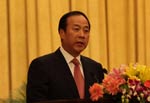
China Daily marks 30th birthday
China's national English language newspaper aims for a top-notch international all-media group.

Room at the inn
The Chinese hotel industry experiences a building boom, prompting fears of oversupply.

Pearls of wisdom
Chinese pearl farmers dominate the world market but now want to work smarter, not harder
